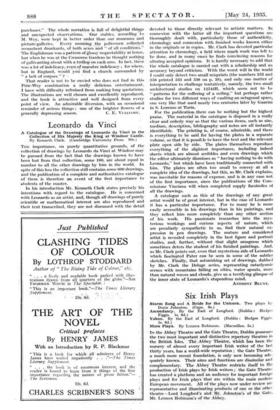Leonardo da Vinci
A Catalogue of the Drawings of Leonardo da Vinci in the Collection of His Majesty the King at Windsor Castle. By Kenneth Clark. (Cambridge University Press. 90s.)
THE importance, on purely quantitative grounds, of the collection of drawings by Leonardo da Vinci at Windsor may be guessed from the fact that the drawings known to have been lost from that collection, some 180, are about equal in number to all the other drawings by him in the world. In spite of this loss the collection still contains some 600 drawings, and the. publication of a complete and authoritative catalogue of them is therefore as event of the first importance to students of the master.
In his introduction Mr. Kenneth Clark states precisely his intentions with regard to the catalogue. He is concerned with Leonardo as an artist, and, though all drawings of purely scientific or mathematical interest are also reproduced and their text transcribed, they are not discussed with the detail
devoted to those directly relevant to artistic matters. In connexion with the latter all the important questions are thoroughly dealt with, particularly those of authenticity, chronology and connexion with finished works known either in the originals or in copies. Mr. Clark has devoted particular
attention to chronology, a field where much work was left to be done, and in many case's he finds convincing reasons for altering accepted opinions. It is hardly necessary to add that the whole catalogue is carried out with a scholarship and an accuracy beyond criticism. With the worst will in the world I could only detect two small misprints (the numbers 353 and 358 printed 533 and 538 on p. 38), and only one matter of interpretation to challenge tentatively, namely, the two small architectural studies on 12542R, which seem not to be " patterns for the coffering of a ceiling," but perhaps rather studies for two different ways of vaulting an octagonal space, one very like that used nearly two centuries later by Guarini in S. Lorenzo at Turin.
For the publication there can be nothing but the highest praise. The material in the catalogue is disposed in a really clear and orderly way so that the various items, such as size, medium, description, bibliography and notes are all instantly identifiable. The printing is, of course, admirable, and there is everything to be said for having the plates in a separate volume, so that it is possiLle to have the text and the relevant plate open side by side. The plates themselves reproduce everything of the slightest importance, including indeed sheets which are almost scribbles and even drawings which the editor ultimately dismisses as " having nothing to do with Leonardo," but which have been traditionally connected with him. The plates are often too small to convey at all a complete idea of the drawings, but this, as Mr. Clark explains, was inevitable for reasons of expense, and is in any case not of the first importance, since the publications of the Corn- missione Vinciana will when completed supply facsimiles of all the drawings.
A catalogue such as this of the drawings of any great
artist would be of great interest, but in the case Of Leonardo it has a particular importance. For to many he is more easily accessible in his drawings than in his paintings, and they reflect him more completely than any other section of his work. His passionate researches into the mys- terious workings and curious aspects of nature, which are peculiarly, sympathetic to us, find their natural ex- pression in pen drawings. The mature and considered artist is revealed completely in the best figure and portrait studies, and, further, without that slight smugness which sometimes deters the student of his finished paintings. And, as Mr. Clark points out, even that mysterious side of Leonardo which fascinated Pater can 'be seen in some of .the subtler sketches. Finally, that astonishing set of drawings, dubbed by Mr. Clark the Deluge series, representing cataclysmic
scenes with mountains falling on cities, water spouts, more than natural waves and clouds, give us a terrifying glimpse of the inner state of Leonardo's stupendous mind.
ANTHONY BLUNT.














































 Previous page
Previous page